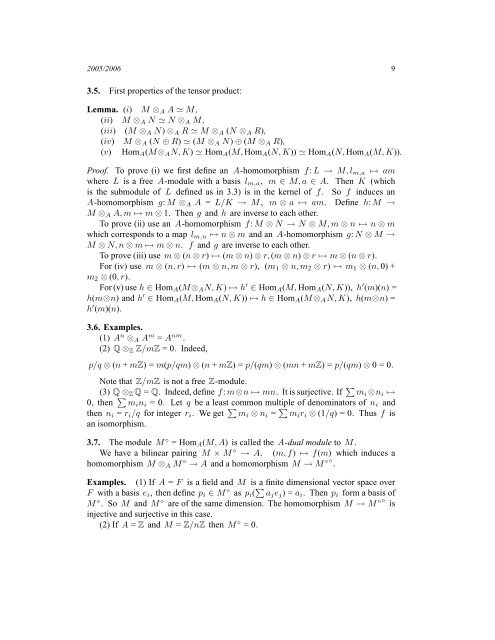Algebra (Unknown 27). - Index of
Algebra (Unknown 27). - Index of
Algebra (Unknown 27). - Index of
Create successful ePaper yourself
Turn your PDF publications into a flip-book with our unique Google optimized e-Paper software.
2005/2006 9<br />
3.5. First properties <strong>of</strong> the tensor product:<br />
Lemma. (i) M ⊗ A A ≃ M ,<br />
(ii) M ⊗ A N ≃ N ⊗ A M ,<br />
(iii) (M ⊗ A N) ⊗ A R ≃ M ⊗ A (N ⊗ A R),<br />
(iv) M ⊗ A (N ⊕ R) ≃ (M ⊗ A N) ⊕ (M ⊗ A R),<br />
(v) Hom A (M⊗ A N, K) ≃ Hom A (M, Hom A (N, K)) ≃ Hom A (N, Hom A (M, K)).<br />
Pro<strong>of</strong>. To prove (i) we first define an A-homomorphism f: L → M, l m,a ↦→ am<br />
where L is a free A-module with a basis l m,a , m ∈ M, a ∈ A. Then K (which<br />
is the submodule <strong>of</strong> L defined as in 3.3) is in the kernel <strong>of</strong> f . So f induces an<br />
A-homomorphism g: M ⊗ A A = L/K → M , m ⊗ a ↦→ am. Define h: M →<br />
M ⊗ A A, m ↦→ m ⊗ 1. Then g and h are inverse to each other.<br />
To prove (ii) use an A-homomorphism f: M ⊗ N → N ⊗ M, m ⊗ n ↦→ n ⊗ m<br />
which corresponds to a map l m,n ↦→ n ⊗ m and an A-homomorphism g: N ⊗ M →<br />
M ⊗ N, n ⊗ m ↦→ m ⊗ n. f and g are inverse to each other.<br />
To prove (iii) use m ⊗ (n ⊗ r) ↦→ (m ⊗ n) ⊗ r, (m ⊗ n) ⊗ r ↦→ m ⊗ (n ⊗ r).<br />
For (iv) use m ⊗ (n, r) ↦→ (m ⊗ n, m ⊗ r), (m 1 ⊗ n, m 2 ⊗ r) ↦→ m 1 ⊗ (n, 0) +<br />
m 2 ⊗ (0, r).<br />
For (v) use h ∈ Hom A (M⊗ A N, K) ↦→ h ′ ∈ Hom A (M, Hom A (N, K)), h ′ (m)(n) =<br />
h(m⊗n) and h ′ ∈ Hom A (M, Hom A (N, K)) ↦→ h ∈ Hom A (M ⊗ A N, K), h(m⊗n) =<br />
h ′ (m)(n).<br />
3.6. Examples.<br />
(1) A n ⊗ A A m = A nm .<br />
(2) Q ⊗ Z Z/mZ = 0. Indeed,<br />
p/q ⊗ (n + mZ) = m(p/qm) ⊗ (n + mZ) = p/(qm) ⊗ (mn + mZ) = p/(qm) ⊗ 0 = 0.<br />
Note that Z/mZ is not a free Z-module.<br />
(3) Q ⊗ Z Q = Q. Indeed, define f: m⊗n ↦→ mn. It is surjective. If ∑ m i ⊗n i ↦→<br />
0, then ∑ m i n i = 0. Let q be a least common multiple <strong>of</strong> denominators <strong>of</strong> n i and<br />
then n i = r i /q for integer r i . We get ∑ m i ⊗ n i = ∑ m i r i ⊗ (1/q) = 0. Thus f is<br />
an isomorphism.<br />
3.7. The module M ◦ = Hom A (M, A) is called the A-dual module to M .<br />
We have a bilinear pairing M × M ◦ → A, (m, f) ↦→ f(m) which induces a<br />
homomorphism M ⊗ A M ◦ → A and a homomorphism M → M ◦◦ .<br />
Examples. (1) If A = F is a field and M is a finite dimensional vector space over<br />
F with a basis e i , then define p i ∈ M ◦ as p i ( ∑ a j e j ) = a i . Then p i form a basis <strong>of</strong><br />
M ◦ . So M and M ◦ are <strong>of</strong> the same dimension. The homomorphism M → M ◦◦ is<br />
injective and surjective in this case.<br />
(2) If A = Z and M = Z/nZ then M ◦ = 0.

















